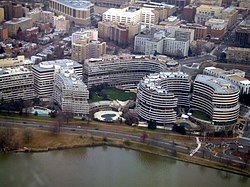
Back فضيحة ووترغيت Arabic فضيحة ووترجيت ARZ Votergeyt qalmaqalı Azerbaijani واترقیت روسوالیغی AZB Уотэргейцкі скандал Byelorussian Уотъргейт Bulgarian ওয়াটারগেট কেলেঙ্কারি Bengali/Bangla Afera "Watergate" BS Escàndol Watergate Catalan Aféra Watergate Czech
| Watergate scandal |
|---|
 |
| Events |
| People |
| ||
|---|---|---|
|
Pre-vice presidency 36th Vice President of the United States Post-vice presidency 37th President of the United States
Judicial appointments Policies First term Second term Post-presidency Presidential campaigns Vice presidential campaigns
 |
||
The Watergate scandal was a major political scandal in the United States involving the administration of President Richard Nixon which began in 1972 and ultimately led to Nixon's resignation in 1974. It revolved around members of a group associated with Nixon's 1972 re-election campaign breaking into and planting listening devices in the Democratic National Committee headquarters at the Watergate Office Building in Washington, D.C., on June 17, 1972, and Nixon's later attempts to hide his administration's involvement.
Following the arrest of the burglars, both the press and the Department of Justice connected the money found on those involved to the Committee for the Re-Election of the President (CRP), the fundraising arm of Nixon's campaign.[1][2] Carl Bernstein and Bob Woodward, journalists from The Washington Post, pursued leads provided by a source they called "Deep Throat" (later identified as Mark Felt, associate director of the FBI) and uncovered a massive campaign of political spying and sabotage directed by White House officials and illegally funded by donor contributions. Nixon dismissed the accusations as political smears, and he won the election in a landslide in November. Further investigation and revelations from the burglars' trial led the Senate to establish a special Watergate Committee and the House of Representatives to grant its Judiciary Committee expanded authority in February 1973.[3][4] The burglars received lengthy prison sentences that they were told would be reduced if they co-operated, which began a flood of testimony from witnesses. In April, Nixon appeared on television to deny wrongdoing on his part and to announce the resignation of his aides. After it was revealed that Nixon had installed a voice-activated taping system in the Oval Office, his administration refused to grant investigators access to the tapes, leading to a constitutional crisis.[5] The televised Senate Watergate hearings by this point had garnered nationwide attention and public interest.[6]
Attorney General Elliot Richardson appointed Archibald Cox as a special prosecutor for Watergate in May. Cox obtained a subpoena for the tapes, but Nixon continued to resist. In the "Saturday Night Massacre" in October, Nixon ordered Richardson to fire Cox, after which Richardson resigned, as did his deputy William Ruckelshaus; Solicitor General Robert Bork carried out the order. The incident bolstered a growing public belief that Nixon had something to hide, but he continued to defend his innocence and said he was "not a crook". In April 1974, Cox's replacement Leon Jaworski issued a subpoena for the tapes again, but Nixon only released edited transcripts of them. In July, the Supreme Court ordered Nixon to release the tapes, and the House Judiciary Committee recommend that he be impeached for obstructing justice, abuse of power, and contempt of Congress. In one of the tapes, later known as "the smoking gun", he ordered aides to tell the FBI to halt its investigation. On the verge of being impeached, Nixon resigned the presidency on August 9, 1974, becoming the only U.S. president to do so. In all 48 people were found guilty of Watergate-related crimes, but Nixon was pardoned by his vice president and successor Gerald Ford on September 8.
Public response to the Watergate disclosures had electoral ramifications: the Republican Party lost four seats in the Senate and 48 seats in the House at the 1974 mid-term elections, and Ford's pardon of Nixon is widely agreed to have contributed to his election defeat in 1976. A word combined with the suffix "-gate" has become widely used to name scandals, even outside the U.S.,[7][8][9] and especially in politics.[10][11]
- ^ Perry, James M. "Watergate Case Study". Class Syllabus for "Critical Issues in Journalism". Columbia School of Journalism, Columbia University. Archived from the original on July 15, 2019. Retrieved July 27, 2018.
- ^ Dickinson, William B.; Cross, Mercer; Polsky, Barry (1973). Watergate: chronology of a crisis. Vol. 1. Washington, D.C.: Congressional Quarterly Inc. pp. 8, 133, 140, 180, 188. ISBN 0-87187-059-2. OCLC 20974031.
- ^ Rybicki, Elizabeth; Greene, Michael (October 10, 2019). "The Impeachment Process in the House of Representatives". CRS Report for Congress. Washington, D.C.: Congressional Research Service, Library of Congress. pp. 5–7. R45769. Archived from the original on January 22, 2020. Retrieved November 7, 2019.
- ^ "H.Res.74 – 93rd Congress, 1st Session". congress.gov. February 28, 1973. Archived from the original on December 30, 2019. Retrieved October 21, 2019.
- ^ "A burglary turns into a constitutional crisis". CNN. June 16, 2004. Archived from the original on November 30, 2020. Retrieved May 13, 2014.
- ^ "'Gavel-to-Gavel': The Watergate Scandal and Public Television". American Archive of Public Broadcasting. Retrieved November 10, 2019.
- ^ Hamilton, Dagmar S. "The Nixon Impeachment and the Abuse of Presidential Power", In Watergate and Afterward: The Legacy of Richard M. Nixon. Leon Friedman and William F. Levantrosser, eds. Santa Barbara, CA: Greenwood Publishing Group, 1992. ISBN 0-313-27781-8
- ^ Smith, Ronald D. and Richter, William Lee. Fascinating People and Astounding Events From American History. Santa Barbara, CA: ABC-CLIO, 1993. ISBN 0-87436-693-3
- ^ Lull, James and Hinerman, Stephen. Media Scandals: Morality and Desire in the Popular Culture Marketplace. New York: Columbia University Press, 1997. ISBN 0-231-11165-7
- ^ Trahair, R.C.S. From Aristotelian to Reaganomics: A Dictionary of Eponyms With Biographies in the Social Sciences. Santa Barbara, CA: Greenwood Publishing Group, 1994. ISBN 0-313-27961-6
- ^ "El 'valijagate' sigue dando disgustos a Cristina Fernández | Internacional". El País. November 4, 2008. Archived from the original on July 2, 2017. Retrieved July 28, 2014.
